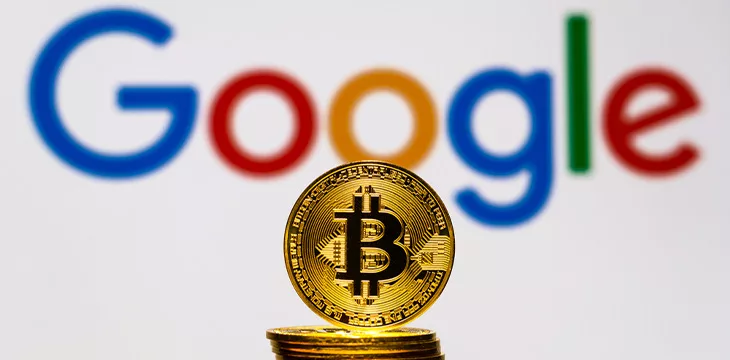|
Getting your Trinity Audio player ready...
|
Google (NASDAQ: GOOGL) is permitting issuers of exchange-traded funds (ETFs) to advertise on its platform, although it’s anyone’s guess whether it will boost the tepid public response to the investment products.
Last December, Google announced that it would update its policy on ‘Cryptocurrencies and related products’ on January 29. The major change being planned was that “advertisers offering Cryptocurrency Coin Trust[s] targeting the United States may advertise those products and services.”
There were a few caveats, including advertisers first garnering account certification by Google. Monday’s updated policy doesn’t specifically mention ETFs, but it does define Cryptocurrency Coin Trusts as “financial products that allow investors to trade shares in trusts holding large pools of digital currency.”
The announcement had BTC maximalists positively giddy at the prospect of ETF managers shilling their funds online to John and Jane Q Public. While some of the issuers have already begun flogging their products online, it’s unclear why maximalists expect a surge of new money rushing in.
Anyone who’s been stuck in an airport or on a gym treadmill where all the TVs are permanently stuck on CNN has been watching commercials promoting Grayscale Investments’ GBTC fund for ages (back when it was still a futures-based product). And despite CNN’s audience being largely comprised of the boomers who have supposedly been in the dark as to the wonders of BTC investing, GBTC isn’t exactly setting the world on fire right now.
Lord knows the BTC ETF market could use the boost. The 10 ETFs that are currently available to consumers saw $500 million in net outflows last week, according to the latest Coinshares report. Since the ETF market began earlier this month, the 11 funds have seen net inflows of just over $759 million.
Outflows from GBTC, the spot-based ETF of the Digital Currency Group (DCG)-owned Grayscale, were a record $2.23 billion last week. GBTC’s woes are largely based on the fact that it imposes a 1.5% annual management fee, by far the highest among the ETFs on offer. The discrepancy is believed to be the predominant factor in ETF volume, as GBTC holders look to reduce their costs by transferring their stakes from one fund to another.
As for which funds are absorbing this GBTC exodus over the first 11 days of trading, it’s a tight race between BlackRock’s iShares BTC Trust (IBIT) and Fidelity Wise Origin BTC Fund (FBTC), with total inflows of nearly $2.2 billion and just over $1.9 billion, respectively. From there, the drop-off is dramatic, with ARK 21 Shares BTC ETF (ARKB) and Bitwise BTC ETF (BITB) both hovering just under $600 million.
The fee-based theory of ETF attractiveness appears to have dawned on the Invesco Galaxy BTC ETF (BTCO), which, through last week, had been one of the less successful ETFs with inflows of only $283 million. Invesco announced Monday that it was cutting its 0.39% fee to 0.25%, putting it in the middle of the pack of non-GBTC offerings.
If there’s a silver lining here, it would be the pace of outflows from GBTC slowing somewhat over the past week. Still, one has to wonder what the other GBTC holders are waiting for and why they appear willing to keep paying GBTC’s significantly higher fees.
Among those who’ve been selling their GBTC was none other than Alameda Research, the bankrupt market-making partner of Sam Bankman-Fried’s equally bankrupt FTX
exchange. It was reported earlier this month that Alameda’s bankruptcy handlers dumped 22 million GBTC shares worth over $1 billion to help pay FTX’s long list of creditors.
It was downright comical to see Barry Silbert, the beleaguered boss of DCG, retweeting stats on ETF trading volume that put GBTC well out in front of its rivals, ignoring the fact that the overwhelming majority of that volume was existing GBTC investors selling to avoid the high fees. As Monday’s Google ad hype demonstrated, ‘crypto’ promoters just can’t resist putting a positive spin on either neutral or downright negative news.
Vanguard unmoved
Investing giant Vanguard earned some enmity from BTC backers when it refused to follow the herd in launching its own ETF or offer its customers similar products issued by anyone else. On January 24, the company issued an explanatory note that pulled no punches.
According to Vanguard’s global head of ETF capital markets, Janel Jackson, BTC is “more of a speculation than an investment … it’s an immature asset class that has little history, no inherent economic value, no cash flow, and can create havoc within a portfolio … even a modest 5% allocation to [BTC] in an otherwise traditional balanced portfolio can drastically raise its risk profile.”
Andrew Kadjeski, Vanguard’s head of brokerage & investments, pointed out that “double-digit percent price drops are routine among cryptocurrencies. Remember that you need a 100% return just to make up for a 50% decline.” Vanguard’s goal is to “help investors save more, trade less, and take a long-term approach—not chase trends and churn their portfolios.”
Sadly, the prevailing mood out there is ‘fall of Rome’ level recklessness. New U.S. Bureau of Economic Analysis figures show Americans’ casino gambling spending is at record highs, having recovered from its pandemic lows and blown past pre-pandemic highs. Viewed through that filter, it’s no wonder the crypto casino exchanges are getting their share of this ‘let it ride’ mentality.
Speaking of, Coinbase (NASDAQ: COIN) announced that it will unveil its hotly anticipated Q4/FY2023 earnings report on Thursday, February 15. All eyes will be watching to see whether trading fees from December’s alt-coin pump were sufficient to keep Coinbase from recording its eighth consecutive quarter of negative earnings.
There’s no revolution here to televise
Maximalists may have celebrated the ETF launches, but more impartial voices can’t help but see the irony of this development. After all, many of these ETF-loving maxis are the same individuals who loudly proclaimed that ‘crypto’ would bring about the downfall of the same Wall Street titans who now manage BTC ETFs. But that was before 2022’s market-wide implosion exposed the rot at the heart of this fraudulent system.
The embrace of Wall Street fat cats illustrates the ease with which crypto baghholders can shift their narrative to suit whatever serves their immediate purpose. For instance, when addressing their customers (aka their exit liquidity), ‘crypto’ is hailed as the future of finance. When addressing federal judges, tokens are suddenly nothing more than function-free Beanie Babies.
As a recent Bloomberg op-ed put it, BTC “being traded on public markets means more information is incorporated into the price, and markets are saying it is not worth much … Going mainstream has revealed its true value. Now it is just another asset class, about as exciting as a bond fund, but much more volatile and with far less ability to diversify its risk.”
A different op-ed in the Financial Times piled on, saying, “crypto has gone from being an exciting and rebellious alternative to traditional finance, a way of ‘being your own bank,’ to simply providing a means for regular investors to diversify their portfolios and for asset managers to eke out a bit of extra revenue. Crypto in 2024 is, in other words, rather boring.”
You know what’s not boring? A blockchain that isn’t limited to serving as a Beanie Baby toybox. A blockchain that can scale to handle nanopayments on a cost-effective scale. A blockchain that can securely enable enterprise-level data management. Other blockchains and tokens might be satisfied with their ‘for display purposes only’ status, but BSV was born to run.
Watch: Unbounded Capital Summit NYC 2023—Running a whole economy on scalable blockchain

 07-12-2025
07-12-2025 





